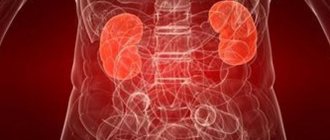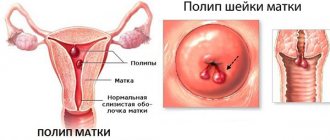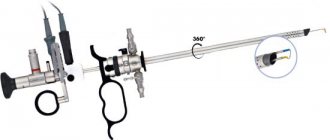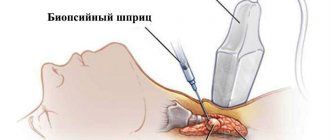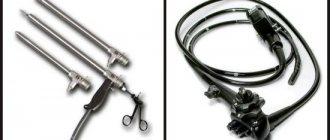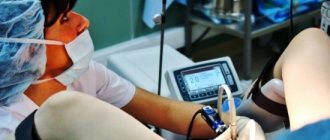Pipe endometrial biopsy is a procedure during which the doctor, using an instrument of the same name (a pipe is something like a very thin plastic syringe with a diameter of 3 mm without a needle), takes endometrial cells (the inner mucous layer of the uterus) from the patient for analysis. Histological, or more precisely, cytological analysis of a sample of the obtained tissue can show cancerous and precancerous changes in uterine cells, a chronic inflammatory process (of the endometrium), and identify dyshormonal changes.
The material is collected in the gynecologist’s office without the use of anesthesia. Typically this takes about 10 minutes .
The effectiveness of this method of taking cell material from the uterus is quite high. However, it is significantly lower than during curettage (scraping) of the uterus, when the entire endometrium is taken for analysis. However, the pipell method makes it possible to diagnose endometrial cancer and hormonal disorders in the early stages. It is recommended for young and nulliparous women in simple situations when there is no suspicion of cancer, for example, before removal of uterine fibroids. During the procedure, the doctor does not expand the cervix using medical instruments, and therefore does not injure it. This is a big plus.
If we compare pipel biopsy and hysteroscopy, then each method has its own advantages. With conventional hysteroscopy, the doctor can visually examine the uterine cavity and remove tumors in it. Take material from a certain area for analysis. Paypel - the procedure is simpler, faster and does not require general anesthesia, but is carried out “blindly”.
At the same time, there is a method of office (mini) hysteroscopy, which is performed without dilation of the cervix and without anesthesia, but the doctor sees everything and can take the tissue for histology. This research is deeper and more effective.
Back to contents
Types of research
Biopsy techniques:
- diagnostic curettage (classical);
- aspirate biopsy;
- pipel biopsy;
- CG biopsy;
- targeted biopsy.
Aspiration biopsy
Surgery using a hysteroscope
Classic curettage of the mucous membrane
This type of procedure involves collecting a biological sample using a surgical instrument. The specialist collects the top layer from the surface of the uterine cavity. The gynecologist can collect the material completely or make several scrapers - trains. The purpose of the event is diagnostic studies of the uterus and therapeutic procedures.
Curettage is done in these situations:
- menstrual irregularities;
- pathological changes in the endometrium;
- neoplasms;
- hyperplasia;
- polyps;
- cysts;
- abundant or poor menstrual flow;
- the presence of intermenstrual discharge;
- diagnosis of cervical tumors;
- spontaneous abortion;
- lack of fetal movements.
If the procedure is carried out on time, the doctor will be able to determine the exact causes of the disease. In this case, competent treatment can slow down the disease and heal the reproductive organ.
Aspirate biopsy with vacuum or aspirator
Aspiration biopsy is a more gentle method compared to curettage. It is not so traumatic because it does not involve a strong expansion of the uterine canal. The risk of complications is significantly reduced. The action is carried out using a thin Brown syringe or a vacuum apparatus.
For women who have never had a child, the procedure may cause some discomfort. To reduce it, your doctor may suggest general anesthesia.
Aspirate biopsy is recommended for any uterine pathology, as well as for unreliable results of ultrasound examination that need clarification.
The advantages of the aspiration technique can be found in the video from the Medical Center channel.
Pipel endometrial biopsy
The collection of biological fragments is carried out using a hollow catheter with a diameter of 3 mm with a slot at the end. Thanks to it, pressure is generated in the device and crypt and endometrial tissue is absorbed into the cylinder. Pipel is considered the most painless method of sample collection, which has almost no flaws.
During the process, the doctor places a Pipel tube into the uterus and pulls on a plunger. Due to the conditions, the technique does not cause injury to the mucous membrane and does not provoke infection. It is recommended for young women without children, with endometrial pathologies and infertility.
CUG biopsy
The operation is performed to expand the cervical uterine canal using a special device. The surgeon scrapes the walls of the mucous membrane, slowly moving towards the internal os of the uterus.
This diagnostic procedure is recommended in cases of monitoring hormone therapy and checking the maturation of the endometrium at natural hormone levels in different phases of the cycle.
CUG biopsy is considered a safe and low-traumatic technique, and is prescribed during one menstrual cycle.
At this time, the surgeon takes biological segments in the form of streaks from several areas of the organ.
Targeted biopsy during hysteroscopy
The essence of the technique is that fragments of the mucosal layer are obtained during endoscopic examination using a hysteroscope. This probe is equipped with a special video camera and an instrument for surgical interventions. The size of the device does not exceed 4 mm in diameter.
Advantages
When performing a pipel biopsy, the patient receives the following benefits:
- painless method that does not require the administration of painkillers;
- infrequent cases of complications;
- there is no need to dilate the cervix;
- due to the simplicity of the procedure, the possibility of incorrect interpretation of the result is eliminated;
- the possibility of performing the procedure frequently due to the absence of negative effects on the body;
- there is no need to hospitalize the patient;
- possibility of carrying out for patients with serious concomitant diseases;
- complete elimination of the possibility of infection, since the procedure uses a disposable tube;
- relatively low price, which allows the examination to be carried out in private.
A sample of tissue is taken from the walls of the uterus using a pipel.
Advantages and disadvantages of the research method
| Procedure | Advantages | Flaws |
| Scraping |
|
|
| Aspiration biopsy |
|
|
| Pipelle biopsy |
|
|
| CUG biopsy |
|
|
| Targeted biopsy |
|
|
Reviews
Today, the pipell biopsy procedure is often used. The following are reviews from patients who underwent this procedure.
Tatyana from Vladivostok: Girls, I underwent a pipel biopsy with IHC. I immediately prepared myself for something completely painful. In fact, I felt pain for a minute, no more. The pain was quite tolerable, like during the first day of menstruation. I was more afraid, so when I got up from the chair, my blood pressure dropped from fear. The most important thing is to relax and start breathing with your stomach.
Ekaterina from Vladimir: Made pipel bioxia for Eco. There was a little discomfort. Immediately after the procedure I went about my business. But during the day I had to take painkillers. The blur lasted for about 2 days. Not as scary as it seemed. Good luck to all!
Natalya from Minsk: I came for the procedure. I have a tilted uterus. It was quite painful, I couldn’t wait for the manipulation to end. The doctor had difficulty going through the pipe bend to take the tissue. It would be better to take a painkiller before the event.
Indications
An endometrial biopsy is prescribed in the following cases:
- causeless bleeding;
- hemorrhage after menopause;
- severe and prolonged bleeding during the cycle;
- hemorrhage after childbirth or abortion;
- bleeding after taking hormonal contraceptives;
- causeless absence of menstruation;
- diagnosis of infertility;
- surgical removal of tumors of various types;
- uterine fibroids;
- hyperplasia;
- ovarian cyst;
- ococtology of the cervix;
- in vitro fertilization (IVF).
What painkillers should you take before the procedure?
Whether or not it is painful to undergo a pipel biopsy depends on the woman’s pain threshold, the skill of the doctor and the presence or absence of pain relief. Since the procedure is carried out on an outpatient basis, in any antenatal clinic, intravenous anesthesia is not advisable.
Ibuprofen , 30-60 minutes before the procedure . It will provide an analgesic effect. “No-shpa” before this , since it is a good antispasmodic, the uterus will not contract too much and painfully and will open more easily for the insertion of a pipel.
In addition, the doctor can use lidocaine spray , sprinkle it on the cervix, this will also somewhat reduce pain.
Sometimes there is a need to take a mild sedative. It may cause drowsiness, so you should not drive until the effects have completely worn off. Ask a friend or family member to drive you home after the procedure.
The most severe pain is felt at the moment of taking material for research. The uterus reacts to the doctor’s actions with spasm. The pain is similar to what happens shortly before the critical days. Some women feel dizzy and have stomach pain. This is called a vasovagal reaction.
Back to contents
Dates
Features of the biopsy:
- if you are concerned about cancer - any day of the menstrual cycle;
- if polyps or similar neoplasms are suspected, immediately after the end of the cycle;
- to establish the cause of non-cyclic bleeding - on the first menstrual day;
- for heavy monthly bleeding - a week after the end of menstruation;
- to diagnose the sensitivity of the endometrium to hormones - no earlier than two weeks;
- for infertility - three days before the expected menstruation.
How to prepare for a uterine endometrial biopsy?
When preparing for an inspection, it is important to adhere to some rules:
- three days before surgery, avoid douching, sexual intercourse, and vaginal medications;
- on the eve of the procedure, perform intestinal lavage;
- to exclude complications after surgery, it is necessary to do a number of special blood and urine tests in advance;
- in the morning before the procedure, the patient must take a shower and remove hair from the genitals;
- If the operation is performed under anesthesia, then twelve hours before the operation it is necessary to refuse food.
Contraindications
Sometimes a biopsy may be delayed for some time or contraindicated:
- Severe anemia.
- Pregnancy.
- Infectious diseases of the genital organs in the acute or chronic stage.
- Pathological processes associated with circulatory disorders - risk of bleeding.
- Infectious diseases - intestinal infections, colds, etc.
- Taking certain medications - anti-inflammatory, anticoagulants, antiplatelet agents.
Decoding the results
Diagnostics shows:
- adenomatosis of the uterus;
- hyperplastic processes;
- atrophy of various types;
- endometritis;
- tumors;
- discrepancy between the phase of the menstrual cycle and the thickness of the mucosal walls.
In the final document, the doctor fills out four parts:
- Information content of a biological sample. It can be inadequate and adequate. In the first case, the diagnosis revealed an insufficient endometrial indicator (the sample was taken incorrectly). In the second case, there are enough endometrial cells to draw the following conclusions.
- Macroscopic description of the drug. At this stage, the weight of the fragments, their size and color are reported. The doctor indicates the consistency of the samples, as well as the presence of blood clots and mucus.
- Microscopic description of the drug. The doctor indicates the size and type of epithelium, as well as the number of layers. The presence of stroma, its density and homogeneity. Uterine glands: their shape and description of the constituent epithelium. If there are lymphoid accumulations, the doctor detects the onset of inflammatory processes.
- Final diagnosis. Here the specialist clarifies which phase of the cycle the endometrium corresponds to and the presence of its expansion. Indicates the characteristics of neoplasms (polyps). How much the walls of the mucous membrane have become thinner and smaller. The presence of atypia and cancer cells. Degeneration of the epithelium and vessels of the chorionic villi.
- Often, in the final diagnosis, a specialist writes that the endometrium is normal in the proliferation phase (secretion, menstruation). This phrase indicates that the patient has no signs of abnormal formations.
Video
How an endometrial biopsy is performed is shown in a video from the PROMATKA channel. RU.
Do you have any questions? Specialists and readers of the HROMOSOMA website will help you ask a question
Was this article helpful?
Thank you for your opinion!
The article was useful. Please share the information with your friends.
Yes
No
X
Please write what is wrong and leave recommendations on the article
Cancel reply
Rate the benefit of the article: Rate the author
Discuss the article:
Features of the rehabilitation period after aspiration biopsy
After the Pipeline diagnosis, the patient needs a recovery period, which consists of following several recommendations:
- Refusal of intimacy for several days after the procedure
- Carrying out regular hygienic care of the genitals;
- Abstain from bathing in a hot bath, visiting a sauna or bathhouse, or drinking alcoholic beverages for 2-3 days after the biopsy.
The procedure may lead to the appearance of pathological symptoms such as bleeding, general malaise, nagging and aching pain in the lower abdomen. Such manifestations are considered normal and disappear on their own within a few days.
Video: Benefits of endometrial aspiration biopsy
Attention!
This article is posted for informational purposes only and under no circumstances constitutes scientific material or medical advice and should not serve as a substitute for an in-person consultation with a professional physician.
For diagnostics, diagnosis and treatment, contact qualified doctors! Number of reads: 1993 Date of publication: 10.20.2017
Gynecologists - search service and appointment with gynecologists in Moscow

